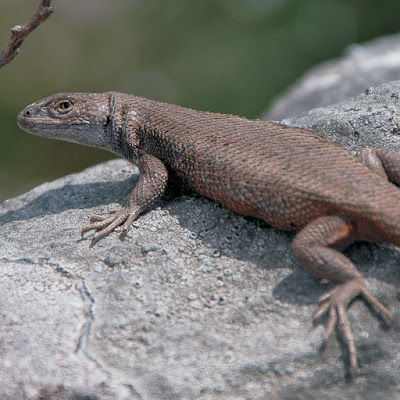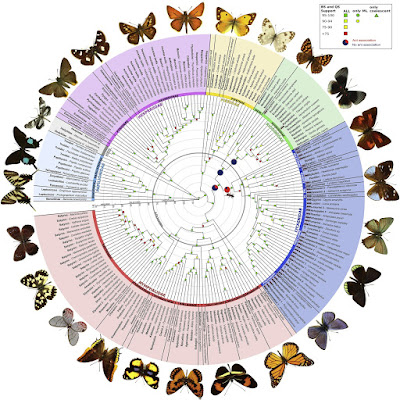[Most Recent Entries] [Calendar View]
Saturday, February 17th, 2018
| Time | Event | ||
| 7:41a | [Herpetology • 2018] Liolaemus absconditus • A New Species of the Liolaemus alticolor-bibronii Group (Iguania: Liolaemidae) from East-central Argentina
Abstract We describe a new species of Liolaemus of the L. alticolor-bibronii group of the subgenus Liolaemus sensu stricto. We studied meristic, morphometric and qualitative pattern characters. Statistical tests were performed in order to evaluate morphological differences among the candidate species and the most closely geographically distributed species. Molecular analyses of Cyt-b mitochondrial gene were performed in order to estimate the position of the new species in relation to other taxa. We also recorded natural history data such as habitat, behavior, reproductive state, diet, and body temperature. Liolaemus absconditus sp. nov. differs from other species of Liolaemus in presenting a distinct combination of morphological character states of lepidosis and color pattern, being phylogenetically close to Liolaemus tandiliensis, Liolaemus gracilis and Liolaemus saxatilis. The new species is a saxicolous and endemic lizard of the Tandilia Mountain Range System of Buenos Aires Province. Keywords: Reptilia, Argentinean Pampas, Endemic, Lizard, Rocky habitat, new taxon Laura Estela Vega, Andrés Sebastián Quinteros, Oscar Aníbal Stellatelli, Patricio Juan Bellagamba, Carolina Block and Enrique Alberto Madrid. 2018. A New Species of the Liolaemus alticolor-bibronii Group (Iguania: Liolaemidae) from East-central Argentina. Zootaxa. 4379(4); 539–555. DOI: 10.11646/zootaxa.4379.4.6 | ||
| 10:00a | [Entomology • 2018] Comprehensive and Dated Phylogenomic Analysis of Butterflies
Highlights • Phylogenomic data provide a novel view of broad butterfly evolutionary relationships • Most current diversity originated after the K-Pg mass extinction • Many accepted higher taxa are para- or polyphyletic • Ant association originated three times independently in blues and metalmarks Summary Butterflies (Papilionoidea), with over 18,000 described species, have captivated naturalists and scientists for centuries. They play a central role in the study of speciation, community ecology, biogeography, climate change, and plant-insect interactions and include many model organisms and pest species. However, a robust higher-level phylogenetic framework is lacking. To fill this gap, we inferred a dated phylogeny by analyzing the first phylogenomic dataset, including 352 loci (> 150,000 bp) from 207 species representing 98% of tribes, a 35-fold increase in gene sampling and 3-fold increase in taxon sampling over previous studies. Most data were generated with a new anchored hybrid enrichment (AHE) gene kit (BUTTERFLY1.0) that includes both new and frequently used (e.g., [6]) informative loci, enabling direct comparison and future dataset merging with previous studies. Butterflies originated around 119 million years ago (mya) in the late Cretaceous, but most extant lineages diverged after the Cretaceous-Paleogene (K-Pg) mass-extinction 65 mya. Our analyses support swallowtails (Papilionidae) as sister to all other butterflies, followed by skippers (Hesperiidae) + the nocturnal butterflies (Hedylidae) as sister to the remainder, indicating a secondary reversal from diurnality to nocturnality. The whites (Pieridae) were strongly supported as sister to brush-footed butterflies (Nymphalidae) and blues + metalmarks (Lycaenidae and Riodinidae). Ant association independently evolved once in Lycaenidae and twice in Riodinidae. This study overturns prior notions of the taxon’s evolutionary history, as many long-recognized subfamilies and tribes are para- or polyphyletic. It also provides a much-needed backbone for a revised classification of butterflies and for future comparative studies including genome evolution and ecology. Conclusion: Our study confirms the power of phylogenomic approaches to resolve challenging arthropod phylogenetic relationships. Adding more than 340 genes to the 10 used previously and tripling the number of taxa included in previous studies confirmed some formerly poorly supported nodes and indicated many novel relationships. A well-supported phylogeny with broad coverage across tribes enables tests of existing hypotheses about higher-level relationships and identification of areas needing further study. Critically, it also serves as a needed scaffold for testing entirely new questions about the tempo and mode of butterfly evolution, such as associations between butterfly and plant clades and the impact of the K-Pg mass-extinction event. Moreover, the phylogeny provides the needed framework for broad comparative studies of the origins of key innovations, such as caterpillar-ant symbioses and other hypothesized drivers of lineage diversification, that have shaped the evolution of this highly studied insect group. Marianne Espeland, Jesse Breinholt, Keith R. Willmott, Andrew D. Warren, Roger Vila, Emmanuel F.A. Toussaint, Sarah C. Maunsell, Kwaku Aduse-Poku, Gerard Talavera, Rod Eastwood, Marta A. Jarzyna, Robert Guralnick, David J. Lohman, Naomi E. Pierce and Akito Y. Kawahara. 2018. A Comprehensive and Dated Phylogenomic Analysis of Butterflies. Current Biology. In Press. DOI: 10.1016/j.cub.2018.01.061 At last, butterflies get a bigger, better evolutionary tree http://phy.so/437934009 via @physorg_com |
| << Previous Day |
2018/02/17 [Calendar] |
Next Day >> |




